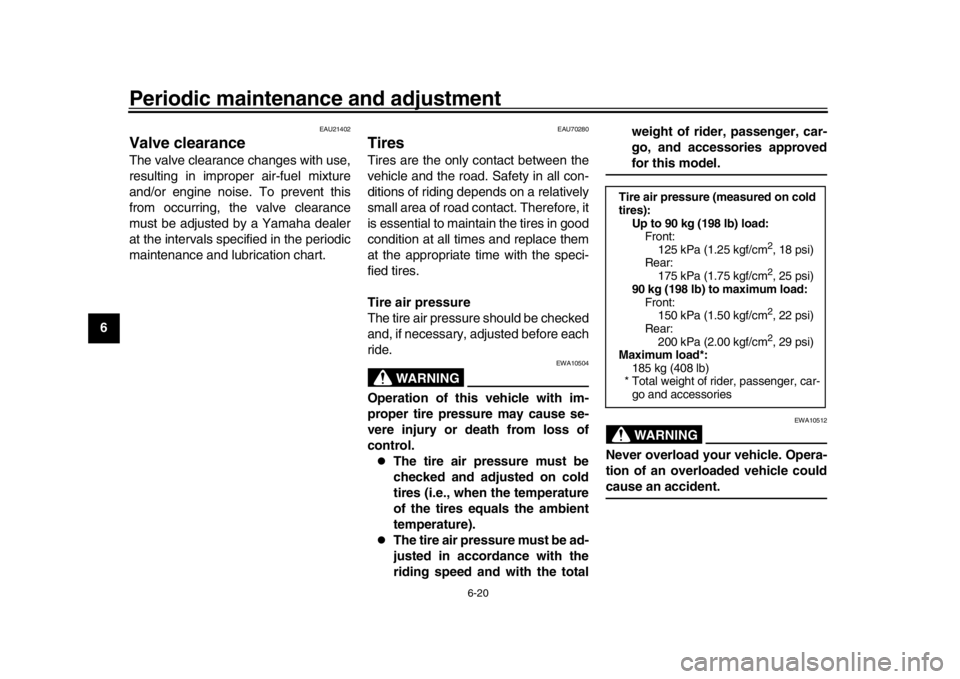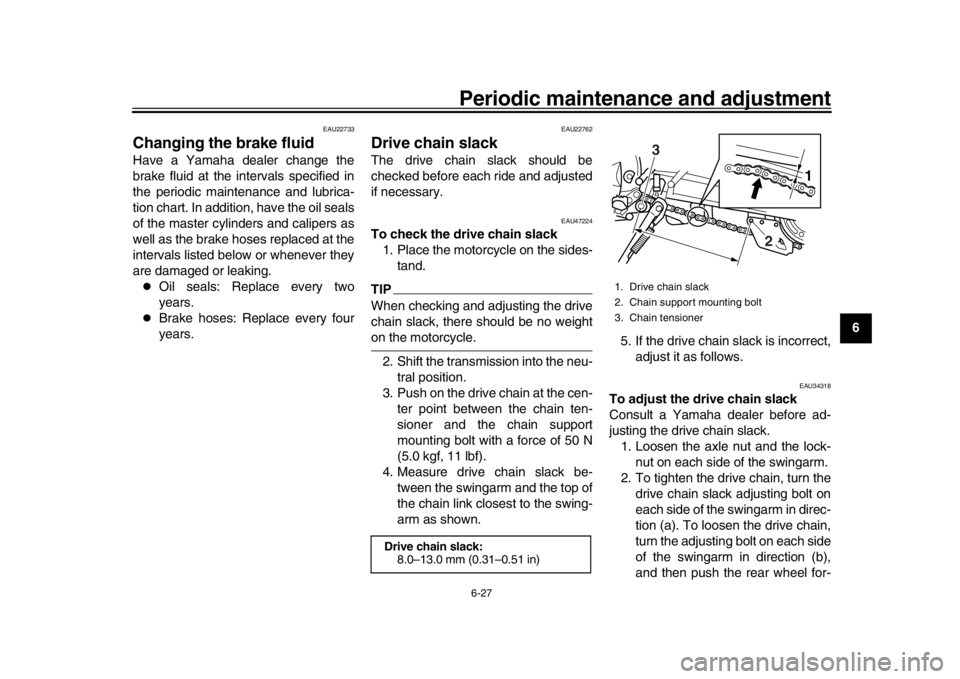weight YAMAHA WR 250R 2016 Owners Manual
[x] Cancel search | Manufacturer: YAMAHA, Model Year: 2016, Model line: WR 250R, Model: YAMAHA WR 250R 2016Pages: 100, PDF Size: 2.65 MB
Page 10 of 100

Safety information
1-3
1
2
3
4
5
6
7
8
9
10
11
12 with fans or open windows and
doors, carbon monoxide can rap-
idly reach dangerous levels.
Do not run engine in poorly venti-
lated or partially enclosed areas
such as barns, garages, or car-
ports.
Do not run engine outdoors where
engine exhaust can be drawn into
a building through openings such
as windows and doors.
Loading
Adding accessories or cargo to your
motorcycle can adversely affect stabili-
ty and handling if the weight distribution
of the motorcycle is changed. To avoid
the possibility of an accident, use ex-
treme caution when adding cargo or
accessories to your motorcycle. Use
extra care when riding a motorcycle
that has added cargo or accessories.
Here, along with the information about
accessories below, are some general
guidelines to follow if loading cargo to
your motorcycle:
The total weight of the operator, pas-
senger, accessories and cargo must
not exceed the maximum load limit. Operation of an overloaded vehicle
could cause an accident.
When loading within this weight limit,
keep the following in mind:
Cargo and accessory weight
should be kept as low and close to
the motorcycle as possible. Se-
curely pack your heaviest items as
close to the center of the vehicle as
possible and make sure to distrib-
ute the weight as evenly as possi-
ble on both sides of the motorcycle
to minimize imbalance or instabili-
ty.
Shifting weights can create a sud-
den imbalance. Make sure that ac-
cessories and cargo are securely
attached to the motorcycle before
riding. Check accessory mounts
and cargo restraints frequently.
Properly adjust the suspension
for your load (suspension-ad-
justable models only), and
check the condition and pres-
sure of your tires. Never attach any large or heavy
items to the handlebar, front
fork, or front fender. These
items, including such cargo as
sleeping bags, duffel bags, or
tents, can create unstable han-
dling or a slow steering re-
sponse.
This vehicle is not designed to
pull a trailer or to be attached to
a sidecar.
Genuine Yamaha Accessories
Choosing accessories for your vehicle
is an important decision. Genuine
Yamaha accessories, which are avail-
able only from a Yamaha dealer, have
been designed, tested, and approved
by Yamaha for use on your vehicle.
Many companies with no connection to
Yamaha manufacture parts and acces-
sories or offer other modifications for
Yamaha vehicles. Yamaha is not in a
position to test the products that these
aftermarket companies produce.
Therefore, Yamaha can neither en-
dorse nor recommend the use of ac-
cessories not sold by Yamaha or
modifications not specifically recom-
Maximum load: 185 kg (408 lb)
BN3-9-E0.book 3 ページ 2015年6月25日 木曜日 午前10時46分
Page 11 of 100

Safety information
1-4
12
3
4
5
6
7
8
9
10
11
12
mended by Yamaha, even if sold and
installed by a Yamaha dealer.
Aftermarket Parts, Accessories,
and Modifications
While you may find aftermarket prod-
ucts similar in design and quality to
genuine Yamaha accessories, recog-
nize that some aftermarket accessories
or modifications are not suitable be-
cause of potential safety hazards to you
or others. Installing aftermarket prod-
ucts or having other modifications per-
formed to your vehicle that change any
of the vehicle’s design or operation
characteristics can put you and others
at greater risk of serious injury or death.
You are responsible for injuries related
to changes in the vehicle.
Keep the following guidelines in mind,
as well as those provided under “Load-
ing” when mounting accessories.
Never install accessories or carry
cargo that would impair the perfor-
mance of your motorcycle. Care-
fully inspect the accessory before
using it to make sure that it does
not in any way reduce ground
clearance or cornering clearance, limit suspension travel, steering
travel or control operation, or ob-
scure lights or reflectors.
Accessories fitted to the handle-
bar or the front fork area can
create instability due to improper
weight distribution or aerody-
namic changes. If accessories
are added to the handlebar or
front fork area, they must be as
lightweight as possible and
should be kept to a minimum.
Bulky or large accessories may seriously affect the stability of
the motorcycle due to aerody-
namic effects. Wind may at-
tempt to lift the motorcycle, or
the motorcycle may become un-
stable in cross winds. These ac-
cessories may also cause
instability when passing or being
passed by large vehicles.
Certain accessories can dis- place the operator from his or
her normal riding position. This
improper position limits the free-
dom of movement of the opera-
tor and may limit control ability,
therefore, such accessories are not recommended.
Use caution when adding electri-
cal accessories. If electrical acces-
sories exceed the capacity of the
motorcycle’s electrical system, an
electric failure could result, which
could cause a dangerous loss of
lights or engine power.
Aftermarket Tires and Rims
The tires and rims that came with your
motorcycle were designed to match the
performance capabilities and to provide
the best combination of handling, brak-
ing, and comfort. Other tires, rims, siz-
es, and combinations may not be
appropriate. Refer to page 6-20 for tire
specifications and more information on
replacing your tires.
Transporting the Motorcycle
Be sure to observe following instruc-
tions before transporting the motorcy-
cle in another vehicle.
Remove all loose items from the
motorcycle.
Check that the fuel cock (if
equipped) is in the “OFF” position
and that there are no fuel leaks.
BN3-9-E0.book 4 ページ 2015年6月25日 木曜日 午前10時46分
Page 31 of 100

Instrument and control functions
3-16
1
234
5
6
7
8
9
10
11
12
always represents the entire adjusting
range. To obtain a precise adjustment,
it would be advisable to check the num-
ber of clicks of each damping force ad-
justing mechanism and to modify the
specifications as necessary.
EAU14794
Front fork bleeding
WARNING
EWA10201
Always bleed both fork legs, other-
wise poor handling and loss of sta-bility may result.
When riding in extremely rough condi-
tions, the air temperature and pressure
in the front fork will rise. This will in-
crease the spring preload and harden
the front suspension. If this occurs,
bleed the front fork as follows.
1. Lift the front wheel off the ground according to the procedure on
page 6-38.TIPWhen bleeding the front fork, there
should be no weight on the front end ofthe vehicle.
2. Remove the bleed screws and al- low all of the air to escape from
each fork leg. 3. Install the bleed screws.
4. Lower the front wheel so that it is
on the ground, and then put the
sidestand down.
1. Bleed screw1
BN3-9-E0.book 16 ページ 2015年6月25日 木曜日 午前10時46分
Page 62 of 100

Periodic maintenance and adjustment
6-20
1
2
3
4
56
7
8
9
10
11
12
EAU21402
Valve clearanceThe valve clearance changes with use,
resulting in improper air-fuel mixture
and/or engine noise. To prevent this
from occurring, the valve clearance
must be adjusted by a Yamaha dealer
at the intervals specified in the periodic
maintenance and lubrication chart.
EAU70280
TiresTires are the only contact between the
vehicle and the road. Safety in all con-
ditions of riding depends on a relatively
small area of road contact. Therefore, it
is essential to maintain the tires in good
condition at all times and replace them
at the appropriate time with the speci-
fied tires.
Tire air pressure
The tire air pressure should be checked
and, if necessary, adjusted before each
ride.
WARNING
EWA10504
Operation of this vehicle with im-
proper tire pressure may cause se-
vere injury or death from loss of
control.
The tire air pressure must be
checked and adjusted on cold
tires (i.e., when the temperature
of the tires equals the ambient
temperature).
The tire air pressure must be ad-
justed in accordance with the
riding speed and with the total weight of rider, passenger, car-
go, and accessories approved
for this model.WARNING
EWA10512
Never overload your vehicle. Opera-
tion of an overloaded vehicle couldcause an accident.Tire air pressure (measured on cold
tires):
Up to 90 kg (198 lb) load:Front:125 kPa (1.25 kgf/cm
2, 18 psi)
Rear: 175 kPa (1.75 kgf/cm2, 25 psi)
90 kg (198 lb) to maximum load:
Front:150 kPa (1.50 kgf/cm2, 22 psi)
Rear:
200 kPa (2.00 kgf/cm2, 29 psi)
Maximum load*: 185 kg (408 lb)
* Total weight of rider, passenger, car- go and accessories
BN3-9-E0.book 20 ページ 2015年6月25日 木曜日 午前10時46分
Page 69 of 100

Periodic maintenance and adjustment6-27
1
2
3
4
567
8
9
10
11
12
EAU22733
Changing the brake fluidHave a Yamaha dealer change the
brake fluid at the intervals specified in
the periodic maintenance and lubrica-
tion chart. In addition, have the oil seals
of the master cylinders and calipers as
well as the brake hoses replaced at the
intervals listed below or whenever they
are damaged or leaking.
Oil seals: Replace every two
years.
Brake hoses: Replace every four
years.
EAU22762
Drive chain slackThe drive chain slack should be
checked before each ride and adjusted
if necessary.
EAU47224
To check the drive chain slack 1. Place the motorcycle on the sides- tand.TIPWhen checking and adjusting the drive
chain slack, there should be no weighton the motorcycle.
2. Shift the transmission into the neu- tral position.
3. Push on the drive chain at the cen- ter point between the chain ten-
sioner and the chain support
mounting bolt with a force of 50 N
(5.0 kgf, 11 lbf).
4. Measure drive chain slack be- tween the swingarm and the top of
the chain link closest to the swing-
arm as shown. 5. If the drive chain slack is incorrect,
adjust it as follows.
EAU34318
To adjust the drive chain slack
Consult a Yamaha dealer before ad-
justing the drive chain slack.1. Loosen the axle nut and the lock- nut on each side of the swingarm.
2. To tighten the drive chain, turn the drive chain slack adjusting bolt on
each side of the swingarm in direc-
tion (a). To loosen the drive chain,
turn the adjusting bolt on each side
of the swingarm in direction (b),
and then push the rear wheel for-
Drive chain slack:8.0–13.0 mm (0.31–0.51 in)
1. Drive chain slack
2. Chain support mounting bolt
3. Chain tensioner
1
3
2
BN3-9-E0.book 27 ページ 2015年6月25日 木曜日 午前10時46分
Page 91 of 100

8-1
1
2
3
4
5
6
789
10
11
12
Specifications
EAU69993
Dimensions:Overall length: 2180 mm (85.8 in)
Overall width: 810 mm (31.9 in)
Overall height: 1230 mm (48.4 in)
Seat height:
930 mm (36.6 in)
Wheelbase: 1420 mm (55.9 in)
Ground clearance: 300 mm (11.81 in)
Minimum turning radius:
2.3 m (7.55 ft)Weight:Curb weight:134 kg (295 lb)Engine:Combustion cycle:4-stroke
Cooling system: Liquid cooled
Valve train:
DOHC
Number of cylinders: Single cylinder
Displacement: 250 cm
3
Bore stroke:
77.0 53.6 mm (3.03 2.11 in)
Compression ratio: 11.8 : 1 Starting system:
Electric starter
Lubrication system:
Wet sump
Engine oil:Recommended brand:YAMALUBE
SAE viscosity grades:
10W-40
Recommended engine oil grade: API service SG type or higher, JASO stan-
dard MA
Engine oil quantity: Oil change:
1.30 L (1.37 US qt, 1.14 Imp.qt)
With oil filter removal: 1.40 L (1.48 US qt, 1.23 Imp.qt)Coolant quantity:Coolant reservoir (up to the maximum level
mark): 0.25 L (0.26 US qt, 0.22 Imp.qt)
Radiator (including all routes):
0.65 L (0.69 US qt, 0.57 Imp.qt)Air filter:Air filter element:Wet elementFuel:Recommended fuel:Premium unleaded gasoline (Gasohol
[E10] acceptable)
Fuel tank capacity: 7.6 L (2.0 US gal, 1.7 Imp.gal)
Fuel reserve amount: 2.1 L (0.55 US gal, 0.46 Imp.gal)
Fuel injection:Throttle body:ID mark:3D71 10Spark plug(s):Manufacturer/model: NGK/CR9EK
Spark plug gap: 0.6–0.7 mm (0.024–0.028 in)Clutch:Clutch type:Wet, multiple-discDrivetrain:Primary reduction ratio:
3.120 (78/25)
Final drive: Chain
Secondary reduction ratio: 3.308 (43/13)
Transmission type:
Constant mesh 6-speed
Gear ratio: 1st:
2.643 (37/14)
2nd: 1.813 (29/16)
3rd: 1.318 (29/22)
4th:
1.040 (26/25)
5th: 0.889 (24/27)
6th: 0.786 (22/28)
BN3-9-E0.book 1 ページ 2015年6月25日 木曜日 午前10時46分
Page 92 of 100

Specifications
8-2
1
2
3
4
5
6
78
9
10
11
12
Chassis:Frame type: Semi double cradle
Caster angle: 26.67
Trail: 111 mm (4.4 in)Front tire:Type:With tube
Size: 80/100-21M/C 51P
Manufacturer/model:
BRIDGESTONE/TW-301FRear tire:Type:With tube
Size:
120/80-18M/C 62P
Manufacturer/model: BRIDGESTONE/TW-302FLoading:Maximum load:
185 kg (408 lb)
* (Total weight of rider, passenger, cargo and accessories)Tire air pressure (measured on cold
tires):Up to 90 kg (198 lb) load:Front:
125 kPa (1.25 kgf/cm
2, 18 psi)
Rear: 175 kPa (1.75 kgf/cm2, 25 psi) 90 kg (198 lb) load - maximum load:
Front: 150 kPa (1.50 kgf/cm
2, 22 psi)
Rear: 200 kPa (2.00 kgf/cm2, 29 psi)
Front wheel:Wheel type:Spoke wheel
Rim size: 21x1.60Rear wheel:Wheel type:Spoke wheel
Rim size: 18x2.15Front brake:Type:Hydraulic single disc brake
Specified brake fluid: DOT 4Rear brake:Type:Hydraulic single disc brake
Specified brake fluid: DOT 4Front suspension:Type:Telescopic fork
Spring: Coil spring
Shock absorber:
Hydraulic damper
Wheel travel: 270 mm (10.6 in)
Rear suspension:Type:
Swingarm (link suspension)
Spring: Coil spring
Shock absorber: Gas-hydraulic damper
Wheel travel:
270 mm (10.6 in)Electrical system:System voltage:12 V
Ignition system:
TCI
Charging system: AC magnetoBattery:Model:
YTZ7S
Voltage, capacity: 12 V, 6.0 Ah (10 HR)Headlight:Bulb type:
Halogen bulbBulb wattage quantity:Headlight:
H4, 60.0 W/55.0 W x 1
Brake/tail light:
LED
Front turn signal light: 10.0 W
Rear turn signal light: 10.0 W 2
BN3-9-E0.book 2 ページ 2015年6月25日 木曜日 午前10時46分